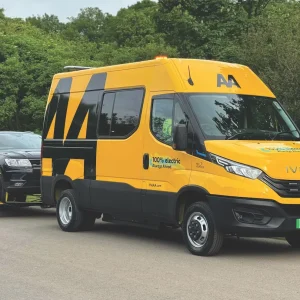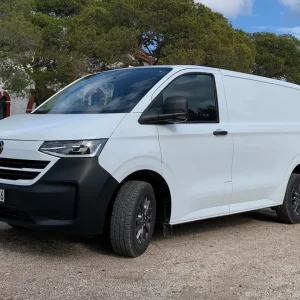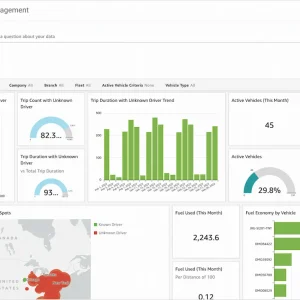At just over 160,000, registrations of vehicles grossing at from 2.8 to 6.5 tonnes hit record levels, up more than 10 per cent on 2006’s total of over 145,000. Sales of 3.5-tonners alone rose by 10.4 per cent, from 74,381 to 82,118, crashing through the 80,000-unit barrier for the first time ever.
Ford led the market in both sectors, selling 50,425 for a 31.5 per cent share in the former and 29,203 for a 35.6 per cent slice of the action in the latter. Mercedes-Benz was the number two player in both cases, finding homes for 19,589 2.8- to 6.5-tonners and 16,789 3.5-tonners, a rise of 27.8 per cent and 35.7 per cent respectively.
VW seized the number three slot in the 2.8-6.5 tonnes category, with 18,568 sales and an 11.6 per cent share while Iveco occupied third place in the 3.5-tonne stakes, with 6,853 registrations and an 8.3 per cent piece of the pie.
Daily Mix
“Last year was the first full year of availability for the new Daily — What Van’s Van of the Year in 2007 — and we took more orders for the vehicle than at any other time in our history,” says Andrea Bucci, Iveco’s UK marketing director. “However, the pattern and mix of those orders held us back a bit in registration terms.
“In the third quarter of the year the previous 70/30 mix in favour of vans changed to 30/70 in favour of chassis cabs. That inevitably lengthened lead times because chassis cabs need bodying; and it is only now that many of those vehicles are being registered.
“Despite this we were still able to improve volumes by 1.0 per cent and orders today remain 30 per cent ahead of budget.”
Conversion Boom
 Bucci says that chassis cabs are accounting for a rising percentage of registrations across the board at 3.5 tonnes. “These days they make up almost 40 per cent of sales, with tippers alone responsible for 10.5 per cent of registrations in 2007,” he observes.
Bucci says that chassis cabs are accounting for a rising percentage of registrations across the board at 3.5 tonnes. “These days they make up almost 40 per cent of sales, with tippers alone responsible for 10.5 per cent of registrations in 2007,” he observes.
A big winner at 3.5 tonnes was Fiat, with a whopping 63.5 per cent rise in sales compare with 2006 — from 2,102 and a 2.8 per cent share to 3,436 and 4.2 per cent — while Nissan was a major-league loser. Registrations collapsed by a hefty 68.9 per cent, from 1,439 to 448.
So what’s underpinning the overall surge in business? “So far as 3.5-tonners are concerned it’s because many operators are trying to avoid running anything heavier because of all the legislation that’s involved; O-licensing, the Drivers Hours rules, tachographs and so on,” says Bucci. “At the other end of the weight scale some firms who have hitherto run smaller vans are choosing to run bigger ones instead to maximise operational flexibility.
“Remember that it costs a minimal extra amount to contract hire a 3.5-tonner as opposed to a 2.8/2.9 tonner.
“Much of the sector’s growth in 2007 was driven by contract hire and rental companies,” he observes. “Northgate, for example, acquires some 10,000 to 12,000 3.5-tonners every year and this has a huge influence on the pattern of the market.”
7.5-tonners
 Bearing in mind the foregoing it’s perhaps not surprising that registrations of 7.5-tonners slumped by over 20 per cent, from 11,853 in 2006 to 9,418; the lowest 7.5-tonne market for 14 years and the first time it failed to hit 10,000 units since 1993.
Bearing in mind the foregoing it’s perhaps not surprising that registrations of 7.5-tonners slumped by over 20 per cent, from 11,853 in 2006 to 9,418; the lowest 7.5-tonne market for 14 years and the first time it failed to hit 10,000 units since 1993.
At least some of the decline may be due to extended chassis delivery times. Confusion over the change from analogue to digital tachograph technology and from Euro 3 to Euro 4 emission standards may have been an important factor too.
It does not look as though 7.5-tonner users are drifting up to 10 to 12 tonnes, says Bucci, although a few may be venturing up to 13 to 15 tonnes.
Daf led the 2007 7.5 tonne market with 2,890 registrations and a 30.7 per cent share, down 24.2 per cent from 2006’s total of 3,811 which resulted in a 32.2 per cent piece of the action. Iveco was number two with 2,164 sales and a 23 per cent share compared with 2,565 and 21.6 per cent; a 15.6 per cent sales drop.
Pity poor Renault Trucks — at 7.5 tonnes it was outsold by Mitsubishi Fuso last year. Marketed through Mercedes-Benz dealerships, the latter’s Canter notched up 497 registrations compared with Renault’s 269; a remarkable achievement. In 2006 Renault achieved 594 sales as opposed to Mitsubishi Fuso’s 515.
3.5-7.5 Tonne
Analysing the figures a little further, it’s interesting to note that Peugeot, Citroën, LDV, electric vehicle maker Modec and Fiat all made their presence felt in the 3.51 to 6.5 tonne arena for the first time. That may in part be due to the number of minibuses that gross at above 3.5 tonne; they accounted for around 42 per cent of total sector sales.
Motorhomes were responsible for over 20 per cent, chassis cabs for almost 25 per cent and vans for roughly 15 per cent.
The entire arena swelled by 54.7 per cent, from 5,710 registrations to 8,836; an unprecedented figure and only 582 below the 7.5 tonne sales total. Fiat did spectacularly well from a standing start with its 4.0 tonne Ducato, with no less than 1,070 sales as opposed to just two in 2006.
“Some environmentally-aware operators are moving from 7.5-tonners to big vans to reduce their carbon footprint and their impact on the urban environment,” says Bucci.
2.8-3.5 Tonne
The 2.8- to 3.49 sector expanded by a modest 6.1 per cent, from 65,095 to 69,057 — a record — with Ford first (18,634, 27 per cent) and Volkswagen second (13,939, 20.2 per cent). Contract hire companies accounted for a high percentage of sales, says Bucci.
This Year?
So what’s going to happen to the market this year? Despite the general level of economic uncertainty, Bucci reckons that light commercial sales above 2.8 tonnes will expand by from two to five per cent.
The drift upwards from smaller vehicles, and downward from larger ones, will aid this growth, he suggests. So will the continued buoyancy of contract hire and daily rental.
“We may see more modest growth in 2009 and 2010 however,” he predicts. “As for annual 7.5 tonne market, I think it will stabilise at from 10,000 to 12,000 units.”
Longer-term, Iveco aims to take 15 per cent of the markets in which Daily competes at 3.5 tonnes and above. It hopes to reach that goal within the next five years. To help it do so it aims to double the number of sites selling the vehicle and boost the number of service points by 25 per cent.

 Sales of big vans boomed in Britain in 2007 reveals Iveco's annual State of the Nation analysis of the commercial vehicle market.
Sales of big vans boomed in Britain in 2007 reveals Iveco's annual State of the Nation analysis of the commercial vehicle market.



